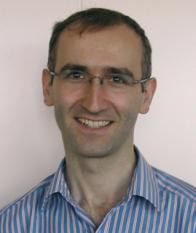Loïc de Roumilly | EDF
14th May, 2012
Mr. Loic De Roumilly, Ultrasonics and Automatic Techniques Group Leader at EDF, kindly accepted to answer a few questions for us.

What is your role at EDF? For how long have you been doing this job?
I have been working at EDF for 3 years as the Ultrasonics and Automatic Techniques Group Leader in the department of NDT (Non Destructive Testing) engineering. Like three other teams of the same size, the goal of my group (composed of ten people) is to develop, or supervise the development by industrial partners of NDT processes, and present them to an expert commission in order to get them qualified. These processes are destined to be deployed on EDF’s existing nuclear fleet, or on the future EPR (European Pressurized Reactor) in Flamanville.
Since when here you been using the CIVA software? (How did you discover the software?)
Before joining EDF, I worked 9 years in the NDT department of the CEA in Saclay. Thus, as soon as I arrived in the Control Methods department, in September 2000, I started using CIVA (version 5 at the time). It is thanks to the simulation I did on this software that I took my first steps in NDT, before being confronted a few months later to the experimental reality. I had the chance to work closely with the modelers, who helped me to understand the models of the software and, at the same time, ultrasonic physics.
I used CIVA software to evaluate performances of industrial NDT processes and, during the course of these studies, I was given the opportunity to compare simulation and experiment for the common fonctionalities and for the more sophisticated models alike, starting at the development stage. Then, in the context of industrial partnerships (linked to the GERIM platform), I was asked to write down specifications for advanced functionalities and evaluate the developed tools.
What are the contributions of CIVA in your activity?
The use of simulation in the qualification process activity is very frequent, either by my group, by the qualification department, or by our industrial partners: upstream, for feasibility and process conception, during the development phase, but also when implementing NDT on site.
More precisely, for feasibility, design or development, CIVA allows to quantify the impact of influent parameters arising from the component’s geometry (or its attenuation), transductors and defects. Furthermore, for “conventional” qualifications, CIVA enables the evaluation of the performances of the process in terms of sensibility, which means determining the size of reflector of a given form, detectable above the notation threshold. Simulation allows us to limit considerably the number of trials (and the number of mock ups and associated artificial defects). Thus, ultrasonic qualification dossiers are based for large part on simulation. However, we try on a local level to validate our simulations with experimental results.
To qualify an NDT process, a performance sheet is created. Some of these include illustrations of the performances. These illustrations can be carried out on mock ups. Others, for many dossiers, are obtained using CIVA simulations.
Finally, when a process is implemented as an expertise, for example when it is carried out beyond the scope of its qualification, the EDF expert may use CIVA simulations to complete and confirm his analysis before giving an opinion.
Besides, in collaboration with the CEA, EDF carries out developments, and capitalizes them in the CIVA software platform: the ATHENA module, for finite elements calculations, wich will soon be available in the commercial version of CIVA, is an example.
Would you recommend CIVA to potential users?
Definitely. It is difficult not to use simulation today, and the use of CIVA can only be encouraged, considering the variety of configurations it can handle and the tools it offers. However, simulation – whichever software is used for it – must be used with a physical and critical sense: the contribution of simulation is much greater when you know precisely what you are expecting from it.
Which are, in your opinion, the improvements which would make CIVA more appropriate for the requirements of the industrial sector?
CIVA can simulate a huge number of configurations, but the stake of simulation in the field of qualification processes is to provide reliable information. The software has been well trialed over many years of its use in many industrial sectors, but the validation works already being carried out must be encouraged, to help users to better identify the domains of validity of the models they use.
Besides, to narrow the gap between simulation and reality, efforts could be made in allowing users to define their parameters more easily, in a more intuitive way, closer to real experiments.
But this is an art form in itself to make a tool intuitive while maintaining the technical level required to handle canonical configurations and subtle expertise cases alike.
